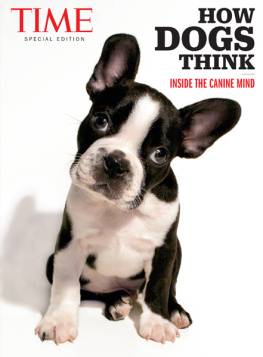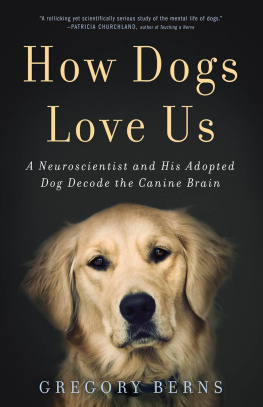Historians, biologists, ethologists, philosophers, psychologists, veterinarians, welfare specialists I cannot think of a book in which I have had to pull upon so wide a circle of experts. My gratitude to these people is enormous thank you. Many, if not most, took time to read sample chapters and provided all sorts of guidance and advice. They are, in alphabetical order, Hana Ayoob, Sally Bate, Paulo Clips, Matthew Cobb, Lucy Cooke, Laura Curtis-More, Lavinia Economu, Holly English, Gabi Fleury, Jan Freedman, Jess French, Samadi Galpayage, Brian Hare, Naomi Harvey, Adam Hart, Matilda Holmes, Alexandra Horowitz, Mila Iesanu, Dale Jamieson, Juliane Kaminski, Niki Khan, Robert Kirk, Jaqui Lethaby, Helen Lewis, Adriana Lowe, Rachel Malkani, Philip Martin, Sean McCormack, dm Miklsi, Ella Miles, Mary Morrow, Wendy Newton, Joy Pate, Jane Perrone, Chloe Petty, Jim Petty, Lauren Robinson, Daniella Dos Santos, Debbie Stevenson, Alison Skipper, Victoria Stillwell, Iain Strachan, Celeste Teo, Bridgett vonHoldt, Sean Wensley, Abigail Woods, Vanessa Woods. In particular, Id like to thank Kath Allen and Ruth Kent (my faithful cuttings-sniffer, also of Chan-fame) for time invested on the final draft of this book.
My thanks to The Dogs Trust (www.dogstrust.org.uk), The PDSA (www.pdsa.org.uk) and the RSPCA (www.rspca.org.uk) for their clear guidance on a number of the issues this book covers. And to the Royal Veterinary College, London. Also to the International Association of Anthrozoology (isaz.net) whose annual conferences proved a hotbed of creative ideas, rich debate and, of course, insightful research. And to Animal Aspirations (www.animalaspirations.com) whose aim is to engage students from diverse backgrounds through veterinary science and other animal-related professions.
I am enormously indebted to my agents at UA, Laura Macdougall and Emily Talbot, for all their hard work and support. I am so lucky to have met you thank you. And to Olivia Davies, also. And to my friends at Bloomsbury who have been so supportive in so many ways for almost (how is this true?) a decade: Jim Martin, Julie Bailey, Angelique Neumann, Lizzy Ewer, Amy Greaves, Sarah Head and Anna (we miss you!) MacDiarmid.
The illustrations that feature in this book come from one of my favourite artists and illustrators, Rebecca Howard. Ive always wanted to work with Rebecca and only a small part of the reason is because shes my sister.
On the theme of kin selection, I would also like to offer an enormous thank-you to my mum and dad for all their continued wonderful positivity and support. I really owe you a great deal. I am also so grateful that we shared a dog, Biff. Only in recent years, since having our own dog, have I come to realise what a trial it must have been looking after him while we were all so young.
Lastly, for Emma and Scarlett and Esme. Thank you for allowing me to sit in the corner of our living room, slamming my fingers on a keyboard, without despairing of my happy and selfish passions. Your positivity each day, and your attitude to life, inspire me.
Finally, to Oz thanks for making the best of all of us.

The known is finite, the unknown infinite; intellectually we stand on an islet in the midst of an illimitable ocean of inexplicability. Our business in every generation is to reclaim a little more land.
T. H. Huxley (1887)
Our story will have many players. A cast of Americans, Russians, French, Scandinavians, Hungarians all with science on their minds and in their notebooks. Throughout the pages of this book, their discoveries, theories and ideas will move like waves between continents, leaving eddies in their wake in which culture, belief and passionate opinions swirl, entangling and coalescing or bouncing apart violently.
But stories like this one must begin in a time and a place, and ours is mid-nineteenth-century London. An age in which a fashion for dogs was blossoming in the middle classes, where Charles Darwins ideas had recently forever changed our understanding of humans and animals, where societal injustice was being challenged in new ways a time at which the life sciences were becoming ever more a laboratory pursuit.
To know this place, both scientifically and culturally, is to get a feel for how far the story of dogs and science has progressed, to see how far we have come.
Our scene-setting exercise begins with Charles Darwin.
Take a moment, if you can, to glance over at a nearby dog. Think about what you share in common. Take in the updown jaws of their skull. The paired nostrils and ears. The inout mechanism of the breathing. Look at the muscular tongue. Notice their eyes looking back at you. Look at the intensity, shining back. The interest. Gaze into their pupils. Take in the eyelashes. If youre lucky, you might share a smile.
Now, if you can, lean in for a stroke. Feel the bones in the legs first. Notice the arrangement and how they mirror those in your own limb bones. Start with the heavy bones at the top of the legs: the humerus (forelegs) and femur (hindlegs). Work your way down to the paired bones that connect to them: the ulna and radius in the forelegs and the fibula and tibia in the hindlegs. As with your own, these bones have within them both yellow and red bone marrow. They are factories that produce blood cells and maintain the body. They are what keeps your dog alive.
Move onwards. Run your fingers down your dogs neck, feeling for the seven neck vertebrae that nearly all mammals possess. Then move your hands lower and guide them in the channel between the shoulder blades (scapulae again, you have them) and down the spine. Put your hand in front of its mouth now. Feel its muscular tongue give you a loving lick. Observe the arrangement of the teeth the incisors, the canines, the molars. Like yours, these are likely to be adult teeth; its milk teeth were lost long ago, probably swallowed while eating. Finally, go paw to paw. Feel with your digits, the digits of your dog. The same familiar arrangement, with dewclaw as thumb.
It is striking to imagine that before the 1800s scientists lacked good evidence to explain why our bodies are so alike why the bones of humans and dogs and, well, most mammals are so similar in their arrangement. The traditional argument, based on Aristotles ideas two millennia ago, was that animals were arranged in a kind of ladder of progress, with lower animals (starfish, sea-squirts and the like) near the bottom, and animals that had achieved perfection (namely, us) at the top (beneath God and then His angels, of course). In this primitive organogram, dogs were often two or three tiers down from humans, somewhere alongside elephants, camels, horses and dragons.
This Bible-led interpretation considered the first dogs as a resource made by God to serve mankind. It saw those earliest dogs as a kind of seventh-day sheepdog that lived to serve but then became corrupted over time into different breeds (races) by jobs locally required of them. During the late-eighteenth century, the recognised European breeds included Siberian, Icelandic and Lapland herding dogs and Pomeranians; greyhounds and mastiffs for sight; hounds, terriers and spaniels for their noses. Due to their numerous breeds, dogs became a useful study species to naturalists of the time, who were eager to understand the diversity of life and what might account for it.
Of all animals, the Dog is also most susceptible of impressions, most easily modified by moral causes, and most subject to alterations occasioned by physical influence, wrote the influential French naturalist Georges-Louis Leclerc, Comte de Buffon. His temperament, faculties, and habits, vary prodigiously; and even the figure of his body is by no means constant.
Next page














